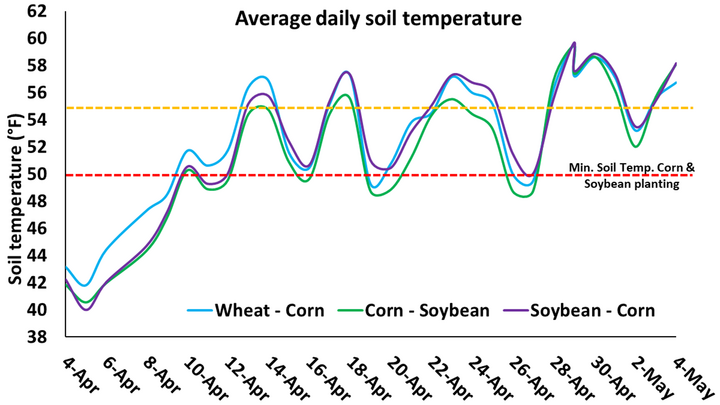By Marcos Ventura and Matias Gabilan et.al
Key Takeaways
Minimum Germination Thresholds Matter — Corn and soybean are safe to plant at ≥50°F soil temperature, and sorghum requires ≥55–60°F. Research shows corn can tolerate soil temps as low as 40°F without injury.
Early Planting Can Increase Yield Potential — Planting during early soil-warming windows, especially in irrigated fields, maximizes yield potential but must be balanced with crop insurance eligibility dates.
Residue Type Affects Soil Warming — Wheat stubble (dryland) warms faster than corn or soybean residue (irrigated), which retain cooler temps.
Soil Moisture Influences Germination Speed and Chilling Risk — Adequate soil moisture is essential for rapid seed imbibition, making it even more important to time planting with both temperature and moisture conditions to support strong emergence.
Soil Temperature Sensors Help Optimize Timing — Using sensors and data loggers gives real-time, site-specific insights, helping growers act during short planting windows while minimizing risk.
Minimum Planting Temperatures for Early Planting
Traditionally, farmers in the west-central Nebraska region wait until the risk of severe frost has passed and the soil has warmed sufficiently to ensure vigorous germination and emergence of corn, soybean and sorghum. The average soil temperatures for which proper seed germination is guaranteed are 50°F for corn and soybeans, and between 55-60°F for sorghum. Even so, records indicate that temperatures close to 40°F for corn would not generate a harmful impact on the corn crop.
With research advances suggesting that early planting can maximize crop yield potential and therefore return on crop input investments, farmers are often dealing with planting into cold conditions. Exploring the potential advantages of adjusting the planting schedule in west-central Nebraska could offer new strategies to optimize agricultural production in the region.
With this objective in mind, students from the Cropping Systems Lab at the West Central Research Extension and Education Center (WCREEC) in North Platte, Nebraska installed soil temperature sensors in early April to track daily soil temperature changes and carry out early planting of corn, soybean and sorghum as soon as the minimum temperature for germination is reached.
Sensor Installation: Method, Location and Experimental Context
The sensors were installed at an average planting depth of 1.75 inches to represent the soil temperature to which the seed would be exposed during germination. Each sensor was connected to a datalogger, which provided online access to hourly soil temperature changes on a phone or laptop.
Three fields with the most common crop residue for planting corn, soybean and sorghum were selected to install soil temperature sensors. These fields were wheat stubble in dryland (wheat-corn), corn residue under irrigation (corn-soybean), and soybean residue under irrigation (soybean-corn or soybean-sorghum). Sensors were installed on April 4, and this article shows soil temperature measurements until May 4.
Analysis of Temperature Records
Overall, the wheat residue on the dryland field had the highest daily soil temperature on most days. Corn residue in the irrigated field had the lowest soil temperature. April 9 was the first day average soil temperatures reached 50°F — the minimum temperature to plant corn and soybean. After that day, there were at least three periods of three days with temperatures above 50°F and long enough for corn and soybeans to be planted and pass the imbibition critical face for chilling injury.
Overall, soil temperature had not reached a minimum sorghum temperature for a considerable period of time, which usually occurs in mid-May.

Final Considerations
Planting early is a pre-condition for achieving high corn and soybean yields, especially in irrigated fields. Our information shows that there have already been three good early planting windows for corn and soybean. However, based on USDA Risk Management Agency (RMA) crop insurance standards, the earliest corn planting date was April 10 for corn and April 25 for soybeans in the North Platte, Nebraska precinct for fields still eligible for a replant payment.
Producers are encouraged to include insurance guidelines before finalizing crop planting date decisions. Other management decisions, such as applying seed fungicide treatments, were not included in this study but may be advised under wet spring and early planting conditions.
Overall, field-stored soil moisture has been in the lower range of historical records in 2025. Rainfall has been 2 inches less than the 30-year average of 5 inches for January through April. Besides temperature, soil moisture at planting is a key factor for good emergence. If good moisture is available, the imbibition phase of germination will occur faster than with low soil moisture content. A faster imbibition phase will reduce the possibility of chilling injury.
Minimum air temperature and frost forecast are often seen as a reference for starting to plant, rather than looking at soil temperature at seed planting depth. This could lead to a delay in planting and yield potential losses. The possible last spring frost crop injury probability has been published in a May 1 CropWatch article.
While aboveground freezing temperatures can occur even after planting, this does not directly affect the underground planted seeds. Our soil temperature experiment records for April 15, April 19 and April 27 show average soil temperatures below 50°F, and the minimum soil temperatures on these days were 41°F, 41°F and 47°F without causing injury to planted seeds.
Finally, it is important to remember that seed emergence will take 12-23 days for corn and 13-25 days for soybean when planted in late April to early May, based on our planting date experiment in North Platte over the last two years at WCREEC.
Source : unl.edu